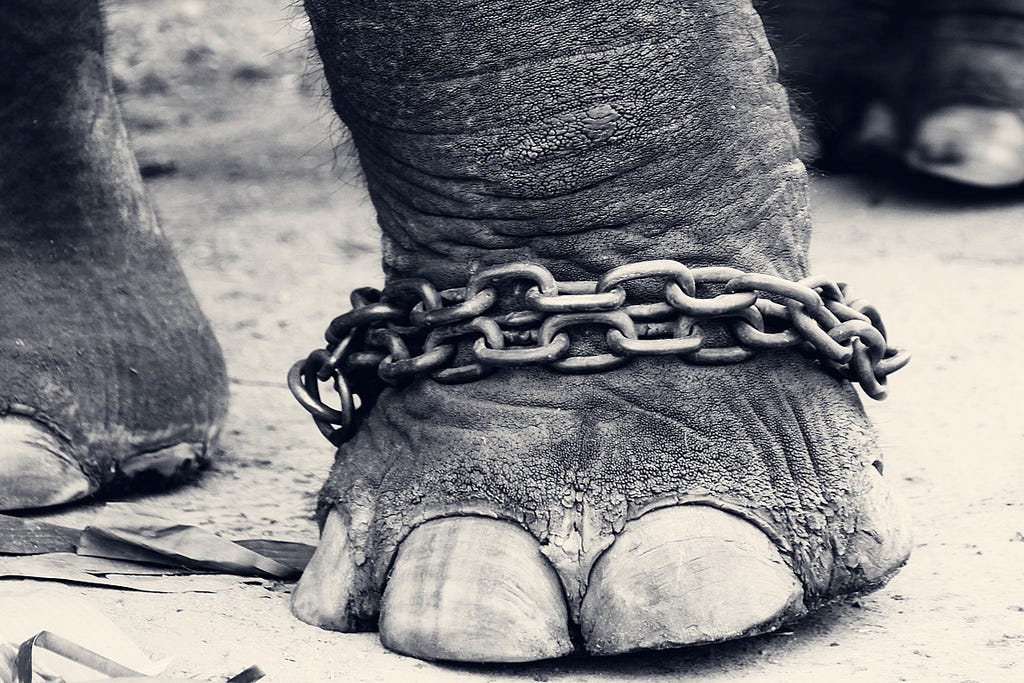
Have you ever noticed a huge elephant outside a circus tent tied by only a rope to a very small stake in the ground?
Have you ever thought if that elephant just kicked his leg that stake would simply pull out of the ground and he could go free? Why does he not even try?
When he is a baby, the elephant tries time and time again to break free, but being a baby he (initially) lacks the strength to do so. After months of trying in vain the baby elephant soon believes it is a waste of time to try and break free and gives up. He is conditioned into thinking this is the way things are and soon he stops trying to break free, never to try again.
We then see him years later believing he cannot break free.
This type mental conditioning happens much too frequently in life, in business and in sport.
In life we are too often conditioned to fit to what society deems acceptable. Children who want to be astronauts are often swayed another direction by disapproving parents, teachers or friends.
This overflows into business where we often fall prey to a “that’s not how things are done around here” culture. Just like the Elephant, junior executives eager to breathe fresh ideas into a company see their ideas ignored and eventually just give up/in andfall into what they are “supposed to do” as deemed by the culture of the company.
There is a great story that illustrates the “That’s how we have always done it”mindset.
The Zero Story
A consultant was visiting a small company to advise on improving general efficiency. The advisor was reviewing a certain daily report which dealt with productivity, absentee rates, machine failure and down-time.
The report was completed on a photocopied templated sheet that was several generations away from the original master-copy. As a result, the headings and descriptions were illegible.
The photocopied forms were particularly fuzzy at the top-right corner, where a small box had a heading that was not clear at all. The advisor was interested to note that the figure ‘0’ had been written in every daily report for the past year.
On questioning the members of staff who completed the report, they told him that they always put a zero in that box, and when he asked them why they looked at each other blankly. “We are not sure about that,” they said, “I guess we’ve just always done it that way.”
The consultant decided to visit the archives to see if he could find a clearer form, to discover what was originally being reported and if it actually held any significance.
When he found the old reports, he saw that the zero return had continued uninterrupted for as far back as the records extended — at least the past thirty years — but none of the forms was any clearer than those presently in use.
He packed away the old papers and turned to leave the room, but something caught his eye. In another box he noticed a folder, promisingly titled ‘master forms’. Sure enough inside it he found the original daily report sheet master-copy, in pristine condition.
In the top right corner was the mysterious box, with the heading clearly shown ……’Number of Air Raids Today’ — ZERO
Following the Game Plan
In some sports, players are conditioned — often unwittingly — to follow a game plan and thus not reach their full potential nor that of the team.
When they are programmed what to do down to every move, they find it difficult to improvise. When they have the confidence to experiment within a set of parameters or themes set out by a coach (leader), that is when the magic happens. (Taking for granted that the team has done all the ground work of diet, sleep, physical and metal preparation).
Choosing the right team of people and surrounding them with the culture, mindsets and tools to succeed is all a leader can do. Once this is done, it is a case of making yourself defunct as much as possible by getting out of the way.

Very often in training sessions both professional and amateur teams train against controlled opposition for fear of injury, low numbers at training or simply this is the culture of a club.

This is called unopposed training, where the “opposition” either hold tackle bags, wear tackle suits or commit to only a grab-only tackle (i.e. not a full tackle). What happens as a result is players literally go through the motions and are conditioned to think that the game plan should work a certain way.
For example, in a training session a player will run at a defending player then slow down just before contact and go through the motion of being tackled because this is what would probably happen in a game. And you know what, if you practice that being a reality it probably will happen that way.
However, what about this alternative. Instead of slowing down coming into the tackle, the player “runs to bust” straight through his opposite defender (yes, even in training). Instead of slowing down just before contact, he speeds up and breaks the tackle (by speeding up just before contact, it is much harder for a defender to judge the tackle).
As a ball carrier the first option should always be to break the defensive line yourself, known as running to bust. Great continuity coaches, Willie Anderson for example, preach this.
In rugby the quickest way to score is to go straight through the opposition, rather than around them. Watch the world’s best ball carriers, watch the world’s best teams, watch the All Blacks. These players pump the legs to break the tackle, “believing” they can break the tackle. As a result, they often do break the tackle. They does not just “fold” into the opposition to set up a phase.
The only way to become better at this is to practice it. If you think even your best ball carriers may only ever get 8–12 carries in a game, the game is not the place to practice. The training session and the game are the places to practice.
So, how to condition your team to run to bust? Introduce full contact matches into training regimes.
Teams like Toulouse don’t even follow a game plan. Instead they have a culture of how they play. They play a certain way, standing up in the tackle offloading to ever-supporting team mates. Players are conditioned from a young age and throughout the Toulouse underage structure to break tackles, offload in contact and run at space and not defenders. Tactical moves are merely starter moves to initiate sequences of play.
If you are an amateur club, train against the U20s or if you have the numbers train against the 2nd XV. This gives the defending team a chance to practice live defence with real hits, not grab tackle. It also gives the attacking team a chance to practice running to bust. Get your team to believe they can break the tackle and not just set up rucks to build phases.
There is another essential piece to perfecting running to bust. As a ball carrier you mustcarry often to become better, indeed to become the best. It might only be 1 carry in 4 that may become great carries, it may only be one per game, but you need to carry often to be in with a chance to make a great carry.
If you are going to make a mistake do it at 100%
When I coached, I coached the players to ensure that if they were going to make a mistake like run into a crowded space, to at least do it at 100%, not to hesitate and to commit.
In most cases in sport if you follow this advice you can get out of that situation when you are backed by your team. This seems obvious, but it is often where a lot of success falls down.
Lessons for Business
In business, we must first put ourselves in a position to succeed in order to succeed.
We must be prepared to fail and fail often in order to succeed. The most successful entrepreneurs have more misses than hits. For example if you are in sales and sit behind a desk all day you won’t sell much, you need to be out with potential clients. In life, if you want to win the lottery, you need to buy a lotto ticket to be in win a chance.
Your business team should not have a pre-ordained structure for how they work. They should have a set of guiding principles, an ethos of how to work. This is why companies need a North Star (or Weenie as our clients in Katawave will recognise). Business needs a gravitational pull towards the way they do business, much like the culture of how the French (used to) play and indeed how the All Blacks play today. Just like teams have a culture of how they play, businesses should have a culture of how they work.
Running to bust in todays business world includes running innovation experiments, trying things, but trying things at 100%.
As mentioned above once you commit, do it to 100%, (this includes the adequate budgets needed), you will learn that this was a mistake, but get out of the fix you may find yourself in. However, you will only get out of the fix if you have the full backing of the team (senior executives).
In conclusion, the most powerful thing leaders can do for their teams is to provide them with the tools to succeed. As a company don’t give them a handbook and expect them to succeed. Give them a North Star / Weenie, give them parameters, give them leadrership and you will soon see them shine, you will see them pull the stake out of the ground andRun to Bust!
— — — — — — — — — — — — — — — — — — — — —
In this weeks Innovation Show we talk to Marc O’Dwyer, CEO of Big Red Book and Big Red Cloud
We talk to Executive Director Innovation at ESB Paul Mulvaney, where we see the great ways ESB has been running to bust.
Finally we talk to CEO and Founder of Connector Conor Lynch.